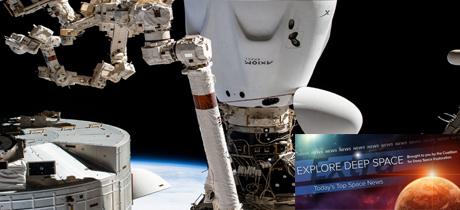In Today’s Deep Space Extra… Artemis I vehicle now back at the Vehicle Assembly Building for upgrades and assessments. Ax-1 crew returns to Earth. NASA to repurpose OSIRIS-REx for second asteroid encounter.
Human Space Exploration
Artemis I vehicle heads back to VAB while NASA discusses what to do next
Coalition Member in the News – Jacobs
NASAspaceflight.com (4/25): NASA began the rollback of the Artemis I Space Launch System (SLS) rocket and Orion capsule from launch pad 39B at the Kennedy Space Center (KSC) on Monday evening. The stack was headed to the Vehicle Assembly Building (VAB) for repairs and upgrades, while NASA management discusses the next step for the Wet Dress Rehearsal (WDR). The rollback follows several propellant system related repairs requirements and an upgrade to the launch pad nitrogen gas flow. Upon resolution of the issues that halted the WDR earlier this month, the rocket and its Orion capsule are to be transported back to the launch pad so efforts to complete the rehearsal may resume. In a new blog post, NASA said the Artemis I vehicle is now at the VAB.
Dragon Endeavour splashes down, concludes historic Ax-1 mission
Coalition Member in the News – Axiom Space
AmericaSpace.com (4/25): Axiom-1 (Ax-1), the first U.S. private astronaut mission to the International Space Station (ISS) returned its four crew members safely to Earth Monday afternoon. The Crew Dragon Endeavour capsule with Mike Lopez-Alegria, Axiom Space executive and retired NASA astronaut, Ohio businessman Larry Connor, and Israeli and Canadian entrepreneurs Lytan Stibbe and Mark Pathy, splashed down off Atlantic Coast of Florida near Jacksonville at 1:06 p.m. EDT. They were greeted quickly by recovery vessels.
Space Science
NASA to repurpose OSIRIS-REx for second asteroid encounter
SpaceNews.com (4/26): NASA announced that the Origins, Spectral Interpretation, Resource Identification, Security-Regolith Explorer, or OSIRIS-REx, spacecraft, on its way back to Earth after collecting samples from asteroid Bennu, will travel to the asteroid Apophis after returning the materials in September 2023. The main spacecraft, after ejecting the sample return container that will land in the Utah desert, will fly by Earth on a trajectory that will bring it to Apophis in 2029, shortly after that asteroid passes just 32,000 kilometers from the Earth. The spacecraft will spend 18 months in the vicinity of Apophis, coming close enough to use its thrusters to brush away surface rocks and expose subsurface materials.
Why so much solar activity? Sun may be outpacing predictions
Space.com (4/25): The sun’s 11-year Solar cycle 25 is well underway, now about two years on course for a peak in 2025. While the entire cycle is predicted to be weaker than its preceding one, recent activity is making headlines with auroral activity. It seems likely the upsurge is linked to the cycle starting about six months earlier than anticipated.
Martian crater looks just like a human fingerprint in this incredible new image
Space.com (4/26): NASA has released a stunning image of a unique crater on Mars with luminous ridges that give it the appearance of a human fingerprint. The crater in the photo is known as Airy-0, a 0.3-mile-wide depression that sits within the much larger Airy crater, which is around 27 miles wide. The newly released picture was taken on September 8, 2021 using the High-Resolution Imaging Science Experiment on NASA’s Mars Reconnaissance Orbiter and was shared by NASA in an Instagram post on April 11.
Other News
U.S. ASAT ban meant to support U.N. discussions on space threats
SpaceNews.com (4/25): At an April 21 webinar by the British American Security Information Council (BASIC), Eric Desautels, acting assistant deputy of state for arms control, verification and compliance, linked the announcement of a U.S. ASAT self-ban to the upcoming U.N. Open-Ended Working Group (OEWG) meeting to discuss norms of behavior for reducing space threats. “The timing of our announcement by the vice president on Monday is meant to spur a meaningful discussion in the Open-Ended Working Group, as we view this as an important tool in our efforts to multilateralize this commitment,” he said. “Having our own proposal at the OEWG of a norm of responsible behavior will allow the U.S. to demonstrate our leadership in this area and to drive a conversation in a way that supports our position and doesn’t undermine U.S. and allied security in the face of what surely will be competing proposals,” he added.
Space startups argue for more agile business models
Coalition Member in the News – Boeing
SpaceNews.com (4/23): According to space entrepreneurs speaking at the Miami Tech Week conference, the U.S. government could address space supply chain problems by embracing nontraditional business models and manufacturing approaches. Technologies such as highly automated production and in-space manufacturing could help the U.S. become less dependent on fragile supply chains, the panelists argued.

